PEX19 binds multiple peroxisomal membrane proteins, is predominantly cytoplasmic, and is required for peroxisome membrane synthesis
- PMID: 10704444
- PMCID: PMC2174547
- DOI: 10.1083/jcb.148.5.931
PEX19 binds multiple peroxisomal membrane proteins, is predominantly cytoplasmic, and is required for peroxisome membrane synthesis
Abstract
Peroxisomes are components of virtually all eukaryotic cells. While much is known about peroxisomal matrix protein import, our understanding of how peroxisomal membrane proteins (PMPs) are targeted and inserted into the peroxisome membrane is extremely limited. Here, we show that PEX19 binds a broad spectrum of PMPs, displays saturable PMP binding, and interacts with regions of PMPs required for their targeting to peroxisomes. Furthermore, mislocalization of PEX19 to the nucleus leads to nuclear accumulation of newly synthesized PMPs. At steady state, PEX19 is bimodally distributed between the cytoplasm and peroxisome, with most of the protein in the cytoplasm. We propose that PEX19 may bind newly synthesized PMPs and facilitate their insertion into the peroxisome membrane. This hypothesis is supported by the observation that the loss of PEX19 results in degradation of PMPs and/or mislocalization of PMPs to the mitochondrion.
Figures
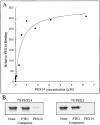
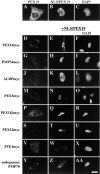
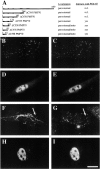
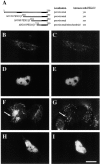


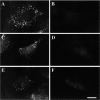

Similar articles
-
Multiple distinct targeting signals in integral peroxisomal membrane proteins.J Cell Biol. 2001 Jun 11;153(6):1141-50. doi: 10.1083/jcb.153.6.1141. J Cell Biol. 2001. PMID: 11402059 Free PMC article.
-
PEX19 is a predominantly cytosolic chaperone and import receptor for class 1 peroxisomal membrane proteins.J Cell Biol. 2004 Jan 5;164(1):57-67. doi: 10.1083/jcb.200304111. J Cell Biol. 2004. PMID: 14709540 Free PMC article.
-
PEX3 functions as a PEX19 docking factor in the import of class I peroxisomal membrane proteins.J Cell Biol. 2004 Mar 15;164(6):863-75. doi: 10.1083/jcb.200311131. Epub 2004 Mar 8. J Cell Biol. 2004. PMID: 15007061 Free PMC article.
-
Targeting signals in peroxisomal membrane proteins.Biochim Biophys Acta. 2006 Dec;1763(12):1629-38. doi: 10.1016/j.bbamcr.2006.08.020. Epub 2006 Aug 25. Biochim Biophys Acta. 2006. PMID: 17020786 Review.
-
Import of peroxisomal membrane proteins: the interplay of Pex3p- and Pex19p-mediated interactions.Biochim Biophys Acta. 2006 Dec;1763(12):1639-46. doi: 10.1016/j.bbamcr.2006.09.030. Epub 2006 Sep 26. Biochim Biophys Acta. 2006. PMID: 17069900 Review.
Cited by
-
A novel PEX12 mutation identified as the cause of a peroxisomal biogenesis disorder with mild clinical phenotype, mild biochemical abnormalities in fibroblasts and a mosaic catalase immunofluorescence pattern, even at 40 degrees C.J Hum Genet. 2007;52(7):599-606. doi: 10.1007/s10038-007-0157-y. Epub 2007 May 30. J Hum Genet. 2007. PMID: 17534573
-
Peroxisome biogenesis and the role of protein import.J Cell Mol Med. 2003 Oct-Dec;7(4):388-400. doi: 10.1111/j.1582-4934.2003.tb00241.x. J Cell Mol Med. 2003. PMID: 14754507 Free PMC article. Review.
-
Identification of Arabidopsis Protein Kinases That Harbor Functional Type 1 Peroxisomal Targeting Signals.Front Cell Dev Biol. 2022 Feb 15;10:745883. doi: 10.3389/fcell.2022.745883. eCollection 2022. Front Cell Dev Biol. 2022. PMID: 35242755 Free PMC article.
-
Multiple distinct targeting signals in integral peroxisomal membrane proteins.J Cell Biol. 2001 Jun 11;153(6):1141-50. doi: 10.1083/jcb.153.6.1141. J Cell Biol. 2001. PMID: 11402059 Free PMC article.
-
The peroxisome: still a mysterious organelle.Histochem Cell Biol. 2008 Apr;129(4):421-40. doi: 10.1007/s00418-008-0396-9. Epub 2008 Feb 15. Histochem Cell Biol. 2008. PMID: 18274771 Free PMC article.
References
-
- Adams G.A., Rose J.K. Structural requirements of a membrane-spanning domain for protein anchoring and cell surface transport. Cell. 1985;41:1007–1015. - PubMed
-
- Bjorkman J., Stetten G., Moore C.S., Gould S.J., Crane D.I. Genomic structure of PEX13, a candidate peroxisome biogenesis disorder gene. Genomics. 1998;54:521–528. - PubMed
-
- Braverman N., Dodt G., Gould S.J., Valle D. Disorders of peroxisome biogenesis. Hum. Mol. Genet. 1995;4:1791–1798. - PubMed
Publication types
MeSH terms
Substances
Grants and funding
LinkOut - more resources
Full Text Sources
Molecular Biology Databases

